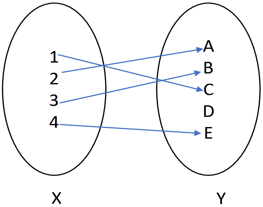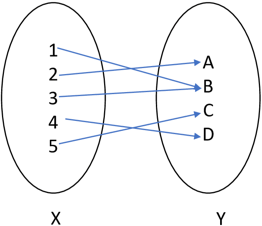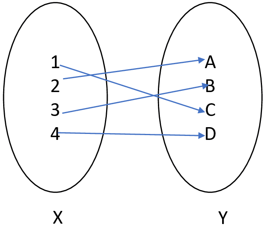This set of Class 12 Maths Chapter 1 Multiple Choice Questions & Answers (MCQs) focuses on “Types of Functions”.
1. The following figure depicts which type of function?

a) one-one
b) onto
c) many-one
d) both one-one and onto
View Answer
Explanation: The above function is one – one. A function f:X→Y is said to be one – one if each of the elements in X has a distinct image in Y.
The condition for a one-one function is for every x1, x2 ∈X, f(x1)=f(x2)⇒x1=x2.
2. The following figure represents which type of function?

a) one-one
b) onto
c) many-one
d) neither one-one nor onto
View Answer
Explanation: The above function is onto or surjective. A function f:X→Y is said to be surjective or onto if, every element of Y is the image of some elements in X.
The condition for a surjective function is for every y∈Y, there is an element in X such that f(x)=y.
3. A function f∶N→N is defined by f(x)=x2+12. What is the type of function here?
a) bijective
b) surjective
c) injective
d) neither surjective nor injective
View Answer
Explanation: The above function is an injective or one-one function.
Consider f(x1)=f(x2)
∴ x12+12=x22+12
⇒x1=x2
Hence, it is an injective function.
4. A function f:R→R is defined by f(x)=5x3-8. The type of function is _________________
a) one -one
b) onto
c) many-one
d) both one-one and onto
View Answer
Explanation: The above is a many -one function.
Consider f(x1)=f(x2)
∴5x13-8=5x23-8
5x13=5x23
⇒x1 = ±x2. Hence, the function is many – one.
5. The function f:R→R defined as f(x)=7x+4 is both one-one and onto.
a) True
b) False
View Answer
Explanation: The given statement is true. f is both one-one and onto.
For one-one: Consider f(x1)=f(x2)
∴7x1+4=7x2+4
⇒ x1=x2.
Thus, f is one – one.
For onto: Now for any real number y which lies in the co- domain R, there exists an element x=(y-4)/7
such that \(f(\frac{y-4}{7}) = 7*(\frac{y-4}{7}) + 4 = y\). Therefore, the function is onto.
6. The following figure depicts which type of function?

a) injective
b) bijective
c) surjective
d) neither injective nor surjective
View Answer
Explanation: The given function is bijective i.e. both one-one and onto.
one – one : Every element in the domain X has a distinct image in the codomain Y. Thus, the given function is one- one.
onto: Every element in the co- domain Y has a pre- image in the domain X. Thus, the given function is onto.
7. A function f:R→R defined by f(x)=5x4+2 is one – one but not onto.
a) True
b) False
View Answer
Explanation: The above statement is false. f is neither one-one nor onto.
For one-one: Consider f(x1)=f(x2)
∴ 5x14+2=5x24+2
⇒x1=± x2.
Hence, the function is not one – one.
For onto: Consider the real number 1 which lies in co- domain R, and let \(x=(\frac{y-2}{5})^{\frac{1}{4}}\).
Clearly, there is no real value of x which lies in the domain R such that f(x)=y.
Therefore, f is not onto as every element lying in the codomain must have a pre- image in the domain.
8. Let A={1,2,3} and B={4,5,6}. Which one of the following functions is bijective?
a) f={(2,4),(2,5),(2,6)}
b) f={(1,5),(2,4),(3,4)}
c) f={(1,4),(1,5),(1,6)}
d) f={(1,4),(2,5),(3,6)}
View Answer
Explanation: f={(1,4),(2,5),(3,6)} is a bijective function.
One-one: It is a one-one function because every element in set A={1,2,3} has a distinct image in set B={4,5,6}.
Onto: It is an onto function as every element in set B={4,5,6} is the image of some element in set A={1,2,3}.
f={(2,4),(2,5),(2,6)} and f={(1,4),(1,5),(1,6)} are many-one onto.
f={(1,5),(2,4),(3,4)} is neither one – one nor onto.
9. Let P={10,20,30} and Q={5,10,15,20}. Which one of the following functions is one – one and not onto?
a) f={(10,5),(10,10),(10,15),(10,20)}
b) f={(10,5),(20,10),(30,15)}
c) f={(20,5),(20,10),(30,10)}
d) f={(10,5),(10,10),(20,15),(30,20)}
View Answer
Explanation: The function f={(10,5),(20,10),(30,15)} is one -one and not onto. The function is one-one because element is set P={10,20,30} has a distinct image in set Q={5,10,15,20}. The function is not onto because every element in set Q={5,10,15,20} does not have a pre-image in set P={10,20,30} (20 does not have a pre-image in set P).
f={(10,5),(10,10),(10,15),(10,20)} and f={(10,5),(10,10),(20,15),(30,20)} are many – one onto.
f={(20,5),(20,10),(30,10)} is neither one – one nor onto.
10. Let M={5,6,7,8} and N={3,4,9,10}. Which one of the following functions is neither one-one nor onto?
a) f={(5,3),(5,4),(6,4),(8,9)}
b) f={(5,3),(6,4),(7,9),(8,10)}
c) f={(5,4),(5,9),(6,3),(7,10),(8,10)}
d) f={(6,4),(7,3),(7,9),(8,10)}
View Answer
Explanation: The function f={(5,3),(5,4),(6,4),(8,9)} is neither one -one nor onto.
The function is not one – one 8 does not have an image in the codomain N and we know that a function can only be one – one if every element in the set M has an image in the codomain N.
A function can be onto only if each element in the co-domain has a pre-image in the domain X. In the function f={(5,3),(5,4),(6,4),(8,9)}, 10 in the co-domain N does not have a pre- image in the domain X.
f={(5,3),(6,4),(7,9),(8,10)} is both one-one and onto.
f={(5,4),(5,9),(6,3),(7,10),(8,10)} and f={(6,4),(7,3),(7,9),(8,10)} are many – one onto.
Sanfoundry Global Education & Learning Series – Mathematics – Class 12.
To practice all chapters and topics of class 12 Mathematics, here is complete set of 1000+ Multiple Choice Questions and Answers.
If you find a mistake in question / option / answer, kindly take a screenshot and email to [email protected]
- Check Class 12 - Mathematics Books
- Practice Class 12 - Biology MCQs
- Practice Class 12 - Physics MCQs
- Practice Class 11 - Mathematics MCQs
- Practice Class 12 - Chemistry MCQs
